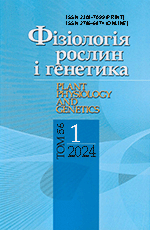Nitrate reduction process occurs in plant only with the participation of enzyme nitrate reductase (NR). Tobacco cell lines resistant to lethal doses of the tungsten (WO42-) and vanadium (VO3-) anions, which inhibit NR, were obtained via cell selection. R0 plants were regenerated from some lines. The NR activity was estimated in leaves. Under normal conditions the NR activity in regenerants exceeded this parameter in wild type plants at 2—3 times. Under enzyme inhibitory pressure conditions NR activity in regenerants was maintained at considerable level too. Probable causes of obtained effects are discussed.
Keywords: tobacco, cell selection, tungstate, vanadate, nitrate reductase
Full text and supplemented materials
Free full text: PDFReferences
1. L'vov, N.P. (1989). Molybdenum in the nitrogen assimilation in plants and microorganisms. Moscow: Nauka [in Russian].
2. Maloshenok, L.G., Uporov, I.V. & Ugarova, N.N. (2002). Catalytic abilities and luminescence spectra of fireflies Luciola mingrelica luciferase with point mutations outside the active center. Vestn. Moscow Univ. Ser. Khimia, 43. No. 6, pp. 359-362 [in Russian].
3. Naidenov, V.G., Vudmaska, M.I., Kornelyuk, A.I. & Matsuka, G. Kh. (2000). Site-directed mutagenesis of lysine residues located in the connection peptide of the nucleotide-binding domain (Rossman fold) of tyrosyl-tRNA synthetase from bovine liver. Biopolym. Cell, 16, No. 4, pp. 275-280 [in Russian]. https://doi.org/10.7124/bc.000571
4. Panin, N.V. (2014). Site-directed mutagenesis of penicillinase from E. coli for changing its catalytic abilities and stability (Unpublished candidate thesis). A.N. Belozersky Inst. of phys.-chem. biology Moscow, Russia, 200 p. [in Russian].
5. Sergeeva, L.E. (2000). The investigation of combined resistance of vanadium- and tungsten-resistant cell lines of tobacco. Fiziologia i biohimia kult. rastenii, 32, No. 6, pp. 49-493 [in Russian].
6. Sergeeva, L.E. (2013). Cell selection with heavy metal ions for obtaining plant genotypes with combined resistance to abiotic stresses. Kiev: Logos [in Russian].
7. Sergeeva, L.E. & Trukhanov V.A. (1997). Obtaining of plant cell lines resistant to tungsten. Fiziologia i biohimia kult. rastenii, 29, No. 1, pp. 51-55 [in Russian].
8. Mendel, R.-R. (1979). Biochemical characterization of nitrate reductase deficient cell lines of Nicotiana tabacum. Erg. Exp. Med., 34, pp. 95-96.
9. Mukund, S. & Adams, M.W.W. (1996). Molybdenum and vanadium do not replace tungsten in the catalytically active forms of the three tungstoenzymes in the hyperthermophilic archeon Pyrococcus furiosus. J. Bacteriol. Jan., 178, pp. 163-167. https://doi.org/10.1128/jb.178.1.163-167.1996
10. Murasige, T. & Skoog, F. (1962). A revised medium for rapid growth and bioassays with tobacco tissue culture. Physiol. Plant., 15, No. 13. pp. 473-497. https://doi.org/10.1111/j.1399-3054.1962.tb08052.x
11. Scholten, & H.J. Feenstra, W.J. (1986). Expression of mutant character of chlorate-resistant mutants of Arabidopsis thaliana in cell culture. J. Plant Physiol., 123, No. 1, pp. 45-54. https://doi.org/10.1016/S0176-1617(86)80065-7
12. Steffen, A. & Schieder, O. (1984). Biochemical and genetical characterization of nitrate reductase deficient mutants of Petunia. Plant Cell Rep., 3, No. 4, pp. 134-137. https://doi.org/10.1007/BF00270206
13. Vaucheret, H., Palanqui, J.C., Mourrain, P. & Elmayan, T. (1997). Nitrate reductase and nitrite reductase as a targets to study gene silencing phenomena in transgenic plants. Euphitica, 30, pp. 195-200. https://doi.org/10.1023/A:1002996818918
14. Yang, Z. & Midmore, D.J. (2005). A model for the circadian oscillations in expression and activity of nitrate reductase in high plants. Ann. Bot., 96, No. 6, pp. 1019-1026. https://doi.org/10.1093/aob/mci254
